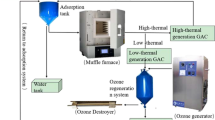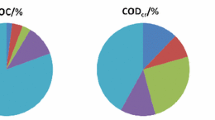Abstract
Dye wastewater is a type of high-concentration, high chromaticity, and high salinity organic wastewater, which is generally treated with activated carbon adsorbent. The effective regeneration of granular activated carbon (GAC) is the key to reducing the operating cost of GAC in the wastewater treatment process. The regeneration characteristics of saturated GAC adsorbed on 288 orange dye wastewater were studied by using the ultrasonic coupled thermal regeneration method. The results showed that the regeneration efficiency of GAC adsorbed on 288 orange dye wastewater increased with the increase of ultrasound power. The optimal ultrasound frequency and regeneration temperature were determined to be 45 kHz and 60 ℃, and the relationship between regeneration times and carbon loss rate was explored. The combination of ultrasound and high-temperature heating methods has successfully improved the regeneration efficiency of GAC and significantly reduced the high-temperature thermal regeneration time of GAC, thereby reducing the mass loss rate of GAC. The performance changes of fresh activated carbon (FAC), saturated activated carbon (SAC), ultrasonic regeneration of activated carbon (UAC), and thermal regeneration of activated carbon (TAC) during the combined regeneration process were explored by characterizing the regenerated GAC. Infrared characterization showed that the C–O group of GAC was significantly weakened after coupling treatment, indicating that ultrasonic treatment can significantly enhance the desorption effect of thermal regeneration. The microjet, shock wave, and cavitation effects generated by ultrasonic treatment restore the specific surface area of GAC, mainly increasing the micropore volume and pore size of GAC, and enhancing the treatment effect of thermal regeneration.












Similar content being viewed by others
Data Availability
Data will be made available on request.
References
Ali J, Bakhsh EM, Hussain N, Bilal M, Akhtar K, Fagieh TM, Danish EY, Asiri AM, Su X, Khan SB (2022) A new biosource for synthesis of activated carbon and its potential use for removal of methylene blue and eriochrome black T from aqueous solutions. Ind Crops Prod 179:114676
Al-Qahtani SD, Snari RM, Alamrani NA, Aljuhani E, Bayazeed A, Aldawsari AM, El-Metwaly NM (2022) Synthesis and adsorption properties of fibrous-like aerogel from acylhydrazone polyviologen: efficient removal of reactive dyes from wastewater. J Market Res 18:1822–1833
Ewuzie U, Saliu OD, Dulta K, Ogunniyi S, Bajeh AO, Iwuozor KO, Ighalo JO (2022) A review on treatment technologies for printing and dyeing wastewater (PDW). J Water Process Eng 50:103273
Fu Y, Ding X, Zhao J, Zheng Z (2020) Study on the effect of oxidation-ultrasound treatment on the electrochemical properties of activated carbon materials. Ultrason Sonochem 69:104921
Gazigil L, Er E, Yonar T (2023) Determination of the optimum conditions for electrochemical regeneration of exhausted activated carbon. Diam Relat Mater 133:109741
Ghaedi H, Ayoub M, Sufian S, Lal B, Uemura Y (2017) Thermal stability and FT-IR analysis of phosphonium-based deep eutectic solvents with different hydrogen bond donors. J Mol Liq 242:395–403
Gustafsson Å, Hale S, Cornelissen G, Sjöholm E, Gunnarsson JS (2017) Activated carbon from kraft lignin: a sorbent for in situ remediation of contaminated sediments. Environ Technol Innov 7:160–168
Hamdaoui O, Naffrechoux E, Tifouti L, Pétrier C (2003) Effects of ultrasound on adsorption–desorption of p-chlorophenol on granular activated carbon. Ultrason Sonochem 10(2):109–114
Hou Z, Wang L, Yan X, Li X, Wang Z, Liang K (2021) Numerical simulation of bubble dynamics under multi-ultrasonic vibrators. CIESC J 72(z1):362–370
Juang R-S, Lin S-H, Cheng C-H (2006) Liquid-phase adsorption and desorption of phenol onto activated carbons with ultrasound. Ultrason Sonochem 13(3):251–260
Kleszyk P, Ratajczak P, Skowron P, Jagiello J, Abbas Q, Frąckowiak E, Béguin F (2015) Carbons with narrow pore size distribution prepared by simultaneous carbonization and self-activation of tobacco stems and their application to supercapacitors. Carbon 81:148–157
Kumar JA, Kumar PS, Krithiga T, Prabu D, Amarnath DJ, Sathish S, Venkatesan D, Hosseini-Bandegharaei A, Prashant P (2021) Acenaphthene adsorption onto ultrasonic assisted fatty acid mediated porous activated carbon-characterization, isotherm and kinetic studies. Chemosphere 284:131249
Li Y, Lin Y, Wang B, Ding S, Qi F, Zhu T (2019) Carbon consumption of activated coke in the thermal regeneration process for flue gas desulfurization and denitrification. J Clean Prod 228:1391–1400
Lim J-L, Okada M (2005) Regeneration of granular activated carbon using ultrasound. Ultrason Sonochem 12(4):277–282
Liu C, Sun Y, Wang D, Sun Z, Chen M, Zhou Z, Chen W (2017) Performance and mechanism of low-frequency ultrasound to regenerate the biological activated carbon. Ultrason Sonochem 34:142–153
Liu Z, Khan TA, Islam MA, Tabrez U (2022) A review on the treatment of dyes in printing and dyeing wastewater by plant biomass carbon. Biores Technol 354:127168
Lu C, Shen L, Zhang Q (2004) Research development of technics and mechanism of dye wastewater treatment by adsorption. Ind Water Treat 24(3):12–16
Márquez P, Benítez A, Hidalgo-Carrillo J, Urbano FJ, Caballero Á, Siles JA, Martín MA (2021) Simple and eco-friendly thermal regeneration of granular activated carbon from the odour control system of a full-scale WWTP: study of the process in oxidizing atmosphere. Sep Purif Technol 255:117782
Pastrana-Martínez LM, López-Ramón MV, Moreno-Castilla C (2009) Adsorption and thermal desorption of the herbicide fluroxypyr on activated carbon fibers and cloth at different pH values. J Colloid Interface Sci 331(1):2–7
Pokhrel N, Vabbina PK, Pala N (2016) Sonochemistry: science and engineering. Ultrason Sonochem 29:104–128
Rae J, Ashokkumar M, Eulaerts O, von Sonntag C, Reisse J, Grieser F (2005) Estimation of ultrasound induced cavitation bubble temperatures in aqueous solutions. Ultrason Sonochem 12(5):325–329
Sabio E, González E, González JF, González-Garcı́a CM, Ramiro A, Gañan J (2004) Thermal regeneration of activated carbon saturated with p-nitrophenol. Carbon 42(11):2285–2293
Sethia G, Sayari A (2016) Activated carbon with optimum pore size distribution for hydrogen storage. Carbon 99:289–294
Teng Z, Han K, Li J, Gao Y, Li M, Ji T (2020) Ultrasonic-assisted preparation and characterization of hierarchical porous carbon derived from garlic peel for high-performance supercapacitors. Ultrason Sonochem 60:104756
Wan Y, Zhao M, Wang Y, Liu T, Wu C (2020) Thermal regeneration effect of volatile organic compounds on waste activated carbon adsorption. J Tian**g Univ Sci Technol 35(3):46–51
Wibawa PJ, Nur M, Asy’ari M, Nur H (2020) SEM, XRD and FTIR analyses of both ultrasonic and heat generated activated carbon black microstructures. Heliyon 6(3):e03546
Yao Y (2016) Enhancement of mass transfer by ultrasound: application to adsorbent regeneration and food drying/dehydration. Ultrason Sonochem 31:512–531
Yu R, Li X, Yang Y-L, Zhang T, Zhou Z (2020) Enhanced desorption performance of aniline-saturated powdered activated carbon using ultrasound assisted with ethanol. Desalin Water Treat 190:267–278
Yuen FK, Hameed BH (2009) Recent developments in the preparation and regeneration of activated carbons by microwaves. Adv Coll Interface Sci 149(1):19–27
Zhang F, Zhao L (2012) Activated carbon regeneration by microwave-ultrasound combined treatment and its application to treatment of phenolic effluent. Petrochem Technol 41(11):1312–1316
Zhang T, Yang Y, Li X, Wang N, Zhou Z (2019) Regeneration of 4-chlorophenol from spent powdered activated carbon by ultrasound. Environ Sci Pollut Res 26(9):9161–9173
Zheng D, Zhou Z, Yu R, Wang M (2021) Characteristics of ultrasonically enhanced low-temperature thermal regeneration of powdered activated carbon: a case study of acetone and aniline. Water 13(9):1298
Funding
This work was supported by Ministry of Industry and Information Technology of the People’s Republic of China (grant numbers [Z135060009002-4–12]).
Author information
Authors and Affiliations
Contributions
All authors contributed to the study conception and design. Material preparation, data collection, and analysis were performed by Kaizheng Shi, Yong Wang, and Bo Chen. The first draft of the manuscript was written by Kaizheng Shi. Zhang Xu and Weisong Fu verified and modified the article, and all authors commented on previous versions of the manuscript. All authors read and approved the final manuscript.
Corresponding author
Ethics declarations
Ethical approval
Not applicable.
Consent to participate
Not applicable.
Consent for publication
All authors approved the final manuscript and the submission to this journal.
Conflict of interest
The authors declare no competing interests.
Additional information
Responsible Editor: Guilherme Luiz Dotto
Publisher's Note
Springer Nature remains neutral with regard to jurisdictional claims in published maps and institutional affiliations.
Rights and permissions
Springer Nature or its licensor (e.g. a society or other partner) holds exclusive rights to this article under a publishing agreement with the author(s) or other rightsholder(s); author self-archiving of the accepted manuscript version of this article is solely governed by the terms of such publishing agreement and applicable law.
About this article
Cite this article
Shi, K., Xu, Z., Wang, Y. et al. Study on regeneration characteristics of granular activated carbon using ultrasonic and thermal methods. Environ Sci Pollut Res 31, 26580–26591 (2024). https://doi.org/10.1007/s11356-024-32734-y
Received:
Accepted:
Published:
Issue Date:
DOI: https://doi.org/10.1007/s11356-024-32734-y




